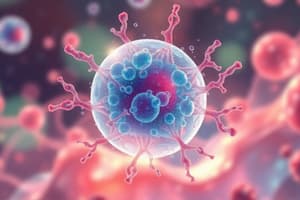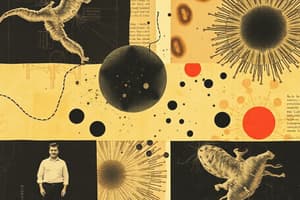Podcast
Questions and Answers
What type of bond involves the transfer of electrons from one atom to another?
What type of bond involves the transfer of electrons from one atom to another?
Ionic bond
What is the main source of energy in the body?
What is the main source of energy in the body?
Carbohydrates
Which macromolecule is composed of carbon, hydrogen, and oxygen with no definite ratio?
Which macromolecule is composed of carbon, hydrogen, and oxygen with no definite ratio?
Lipids
Name a simple sugar that is an important source of cell energy.
Name a simple sugar that is an important source of cell energy.
What is the energy storage form in animals?
What is the energy storage form in animals?
What is the principle sugar transported throughout the bodies of plants?
What is the principle sugar transported throughout the bodies of plants?
Who is considered the Father of Microbiology and the first to invent a microscope?
Who is considered the Father of Microbiology and the first to invent a microscope?
What is the fourth step in the Scientific Method?
What is the fourth step in the Scientific Method?
What is the ultimate goal of science according to the Scientific Method?
What is the ultimate goal of science according to the Scientific Method?
Who discovered cells using a 'cork' specimen in 1665?
Who discovered cells using a 'cork' specimen in 1665?
What is the process of inventing a microscope called?
What is the process of inventing a microscope called?
What is the purpose of the sixth step in the Scientific Method?
What is the purpose of the sixth step in the Scientific Method?
What is the process by which living cells convert non-living inorganic and organic molecules into living cells?
What is the process by which living cells convert non-living inorganic and organic molecules into living cells?
What is the central idea of Darwin's theory of evolution, published in 1858?
What is the central idea of Darwin's theory of evolution, published in 1858?
What are the two types of metabolic processes that occur in cells?
What are the two types of metabolic processes that occur in cells?
What is the term for the ability of living things to react to environmental changes or stimuli, often resulting in adaptation?
What is the term for the ability of living things to react to environmental changes or stimuli, often resulting in adaptation?
Who is considered the 'Father of Genetics' and formulated the Law of Segregation?
Who is considered the 'Father of Genetics' and formulated the Law of Segregation?
What is the term for the modification that promotes the likelihood of survival, which leads to evolution?
What is the term for the modification that promotes the likelihood of survival, which leads to evolution?
What is the focus of study in cytology?
What is the focus of study in cytology?
Who proposed the theory of biogenesis in 1865?
Who proposed the theory of biogenesis in 1865?
What is the term for the state of balance or equilibrium within an organism's internal environment?
What is the term for the state of balance or equilibrium within an organism's internal environment?
What is the primary unit of life according to the cell theory?
What is the primary unit of life according to the cell theory?
What branch of biology deals with the study of fungi?
What branch of biology deals with the study of fungi?
Who is credited with proposing the cell theory, along with Schleiden and Schwann?
Who is credited with proposing the cell theory, along with Schleiden and Schwann?
What are the three subatomic particles found in an atom and where are they located?
What are the three subatomic particles found in an atom and where are they located?
What is a molecule and how does it form?
What is a molecule and how does it form?
What is covalent bonding and where does it occur?
What is covalent bonding and where does it occur?
What is the octet rule and what does it have to do with covalent bonding?
What is the octet rule and what does it have to do with covalent bonding?
What are the differences between organic and inorganic compounds?
What are the differences between organic and inorganic compounds?
What is the relationship between atomic structure and chemical bonding?
What is the relationship between atomic structure and chemical bonding?
Flashcards are hidden until you start studying




